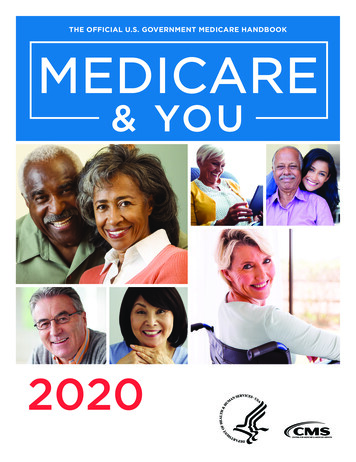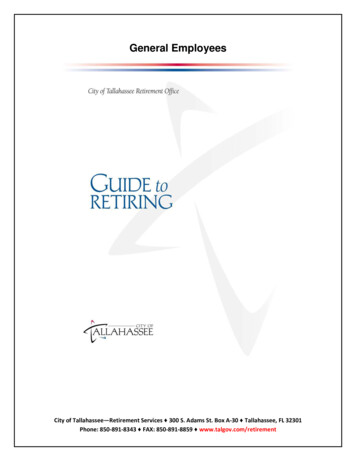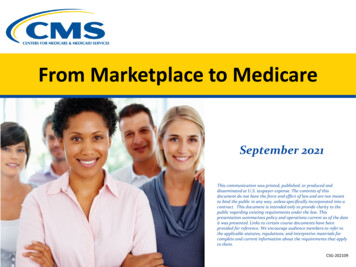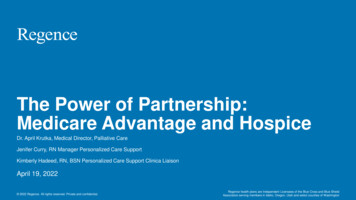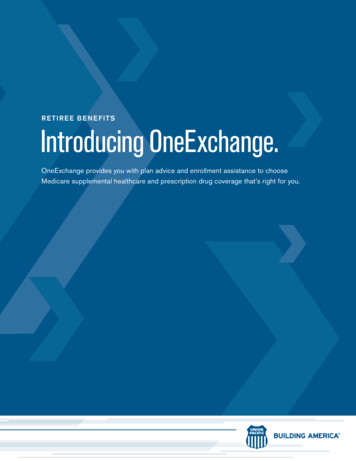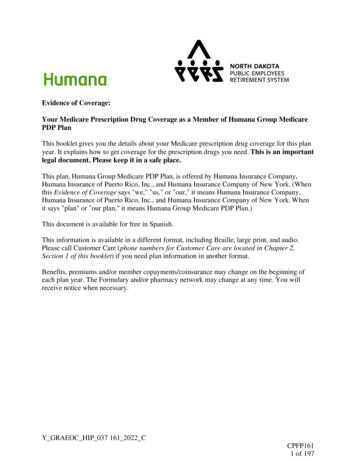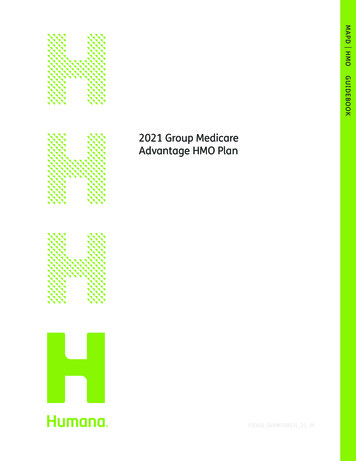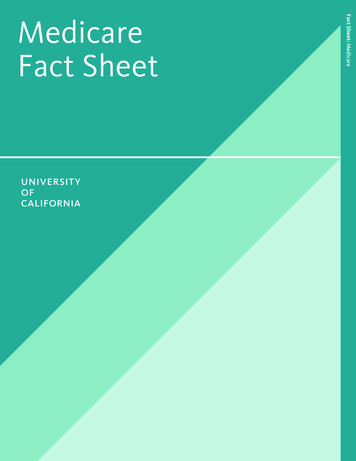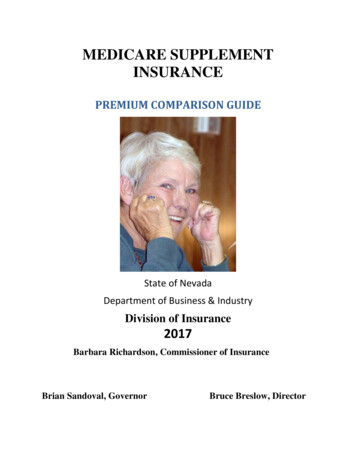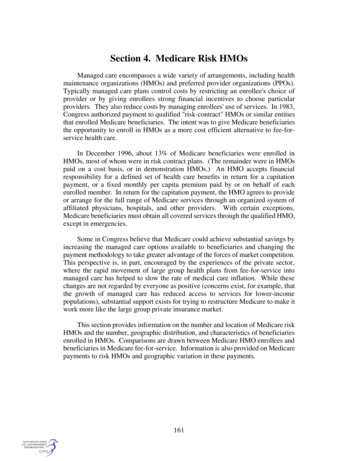
Transcription
Section 4. Medicare Risk HMOsManaged care encompasses a wide variety of arrangements, including healthmaintenance organizations (HMOs) and preferred provider organizations (PPOs).Typically managed care plans control costs by restricting an enrollee's choice ofprovider or by giving enrollees strong financial incentives to choose particularproviders. They also reduce costs by managing enrollees' use of services. In 1983,Congress authorized payment to qualified "risk-contract" HMOs or similar entitiesthat enrolled Medicare beneficiaries. The intent was to give Medicare beneficiariesthe opportunity to enroll in HMOs as a more cost efficient alternative to fee-forservice health care.In December 1996, about 13% of Medicare beneficiaries were enrolled inHMOs, most of whom were in risk contract plans. (The remainder were in HMOspaid on a cost basis, or in demonstration HMOs.) An HMO accepts financialresponsibility for a defined set of health care benefits in return for a capitationpayment, or a fixed monthly per capita premium paid by or on behalf of eachenrolled member. In return for the capitation payment, the HMO agrees to provideor arrange for the full range of Medicare services through an organized system ofaffiliated physicians, hospitals, and other providers. With certain exceptions,Medicare beneficiaries must obtain all covered services through the qualified HMO,except in emergencies.Some in Congress believe that Medicare could achieve substantial savings byincreasing the managed care options available to beneficiaries and changing thepayment methodology to take greater advantage of the forces of market competition.This perspective is, in part, encouraged by the experiences of the private sector,where the rapid movement of large group health plans from fee-for-service intomanaged care has helped to slow the rate of medical care inflation. While thesechanges are not regarded by everyone as positive (concerns exist, for example, thatthe growth of managed care has reduced access to services for lower-incomepopulations), substantial support exists for trying to restructure Medicare to make itwork more like the large group private insurance market.This section provides information on the number and location of Medicare riskHMOs and the number, geographic distribution, and characteristics of beneficiariesenrolled in HMOs. Comparisons are drawn between Medicare HMO enrollees andbeneficiaries in Medicare fee-for-service. Information is also provided on Medicarepayments to risk HMOs and geographic variation in these payments.161
162Figure 4.1.Risk HMOs Participating in Medicare, 1987-1996Risk contract HMOs (or risk HMOs) are HMOs that contract with the Medicareprogram to provide Medicare’s package of benefits to enrolled beneficiaries. Therisk HMOs receive a predetermined monthly payment from Medicare for eachenrolled beneficiary, regardless of the actual medical care utilization of the enrollee.Risk HMOs were authorized by the Tax Equity and Fiscal Responsibility Act of1982 (TERFA) and are sometimes called TEFRA HMOs.Participation of risk contract HMOs in Medicare declined from 1987 to theearly 1990s when many plans terminated existing contracts. However, the totalnumber of health plans signing risk contracts with the Medicare program more thandoubled between 1993 and 1996. The rapid increase starting in 1993 shows no signsof abating. As of December 1996, another 67 risk plan applications were pendingwith the Health Care Financing Administration (HCFA).TABLE 4.1.Risk HMOs Participating inMedicare 996Number of Plans161155131969396110154183241NOTE: Table prepared by CRS.
Figure 4.1. Risk HMOs Participating in Medicare, 1987-1996300number of risk 941995YearSource: Figure prepared by CRS based on Physician Payment Review Commission (PPRC), Medicare Risk PlanParticipation and Enrollment: A Chart Book , December, 1996, Chart 1.1996
164Figure 4.2.Beneficiaries Enrolled in Medicare Risk HMOs, 1990-2000There has been a steady growth in enrollment in Medicare risk HMOs duringthe 1990s, reaching 11% of all beneficiaries in December 1996. Between 1993 and1996, enrollment doubled. The annual rate of growth over the last several years hasbeen in the range of 25% to 35%. The Congressional Budget Office (CBO) projectsthat enrollment in risk plans will reach about 19.4% of all beneficiaries by 2000,assuming no changes in policy.TABLE 4.2.Beneficiaries Enrolled inMedicare Risk HMOs, 1990-2000(in percent)Year19901991199219931994199519962000Risk E: Data for year 2000 areprojected. Table preparedby CRS.
Figure 4.2. Beneficiaries Enrolled in MedicareRisk HMOs, 1990-200025%percent of 199519962000projectedSource: Figure prepared by CRS based on PPRC Chart Book , Dec-96, chart 3; CBO, Jan-97 Baseline Medicare, Jan. 1,1997.
166Figure 4.3.Distribution of Medicare Beneficiaries, by Number of RiskHMOs Available in Their Area, 1995-1996Although over 200 risk HMO plans participate in Medicare, each is availableonly to beneficiaries in a specific service area. Plans define a service area as a setof counties and county parts, itemized at the zip code level. In June 1996, 63% ofall Medicare beneficiaries lived in a zip code that was served by at least one riskplan. About half of all beneficiaries had access to a choice of plans, and one-fourthhad five or more plans available to them. Over the year from June 1995 to June1996, the proportion of all beneficiaries with access to at least one risk plan rose 8percentage points, while the proportion with access to at least five plans had risen 11percentage points.TABLE 4.3.Distribution of Medicare Beneficiaries, by Number of RiskHMOs Available in Their Area, 1995-1996(in percent)Number of RiskHMOs 161413Two to four262825Five or more141625NOTE: Table prepared by CRS based on PPRC analysis ofHCFA data.
Figure 4.3. Distribution of Medicare Beneficiaries, by Number of RiskHMOs Available in Their Area, 1995-1996percent of 0%15%10%5%0%NoneOneTwo to FourNumber of risk HMOsSource: Figure prepared by CRS based on PPRC Chart Book, Dec. 1996, Chart 2.Five or More
168Figure 4.4.Medicare Beneficiaries in Urban and Rural LocationsWho Are Enrolled in Risk HMOs, June 1996Patterns of enrollment in risk contract HMOs are not uniform across urban andrural locales. Risk plan enrollment in central urban areas (generally, the cities at thecore of metropolitan areas) was about 20% in June 1996, about twice the level ofenrollment in outlying urban areas. Risk HMO enrollment in rural areas is about 1%.TABLE 4.4.Medicare Beneficiaries in Urban andRural Locations Who Are Enrolledin Risk HMOs, June 1996(in percent)Central urbanOther urbanRural-urban fringeOther ruralRisk-ContractPlans20.58.61.40.7NOTE: Table prepared by CRS based onPPRC analysis of HCFA data.
Figure 4.4. Medicare Beneficiaries in Urban and Rural Locations Whoare Enrolled in Risk HMOs, June 1996percent of beneficiaries25%20%15%10%5%0%Central urbanOther urbanRural-urban fringeSource: Figure prepared by CRS based on PPRC Chart Book , Dec. 1996, Chart 2.Other rural
170Figure 4.5.Variation in Number of Risk HMOs Available to MedicareBeneficiaries in Urban and Rural Locations, June 1996The availability to Medicare beneficiaries of risk contract plans is much greaterin urban areas than in rural areas. A choice of risk plans is available to mostresidents of central urban areas. By contrast, rural beneficiaries rarely have even asingle plan available to them.TABLE 4.5.Variation in Number of Risk HMOs Available to MedicareBeneficiaries in Urban and Rural Locations, June 1966(in percent)0 PlansCentral urban1 Plan2 to 4Plans5 orMorePlans093259Other urban32163121Rural-urban fringe791570Other rural92630NOTE: Table prepared by CRS based on PPRC analysis of HCFA data.
Figure 4.5. Variation in Number of Risk HMOs Available to MedicareBeneficiaries in Urban and Rural Locations, June 1996percent of beneficiaries100%90%0 plans1 plan80%2 to 4 plans5 or more plans70%60%50%40%30%20%10%0%Rural-urban fringeOther ruralOther urbanSource: Figure prepared by CRS based on PPRC Chart Book , Dec. 1996, Chart 4.Central urban
172Figure 4.6.Medicare Beneficiaries Enrolled in Risk HMOs, by StateDecember 1996Enrollment patterns are not uniform on a regional basis, with Medicare riskHMO enrollment higher in western states. Over 25% of the total number ofMedicare beneficiaries residing in three western states are in risk HMOs. InArizona, 34% of its Medicare beneficiaries are enrolled in Medicare risk HMOs;California (35%); and Oregon (27%). The only eastern states where enrollment tops10% of all Medicare beneficiaries living in those states are: Florida (22%);Massachusetts (14%); Pennsylvania (16%); and Rhode Island (12%).
Figure 4.6. Medicare Beneficiaries Enrolled in Risk HMOs, by State,December 1996Greater than 10 percent (11)2 to 10 percent(15)Less than 2 percent(25)SOURCE: Map prepared by CRS based on PPRC analysis of Medicare Managed Care Contract Reports, December1996.
174Figure 4.7.Distribution of Medicare Risk HMO EnrolleesAmong Selected States, 1994-1995Medicare risk HMO enrollees are far more concentrated geographically than areMedicare beneficiaries as a whole. As of December 1995, 52% of all Medicare riskHMO enrollees lived in California and Florida, even though only 17% of allbeneficiaries live in those two states.TABLE 4.7.Distribution of Medicare Risk HMOEnrollees Among Selected States1994-1995(in percent)StateArizonaCaliforniaFloridaNew 95)637155455NOTE: Table prepared by CRS.TotalMedicarePopulation(9/94)21077166
Figure 4.7. Distribution of Medicare Risk HMO Enrollees AmongSelected States, 1994-1995percent of all Medicare risk HMO enrollees40%35%State’s % of Total RiskEnrollment (12/95)State’s % of Total MedicarePopulation (9/94)30%25%20%15%10%5%xaslvannsyPeSource: Figure prepared by CRS based on HCFA, Profiles of Medicare, Chart MC-5, p. 99.TenianegoYwNeOrorkaoridFlorlifCaArizonania0%
176Figure 4.8.Growth in Medicare Risk HMO EnrollmentDecember 1995-December 1996(New Enrollees as a Percent of Previous State Enrollment)The traditional definition of growth in Medicare HMO enrollment is the changein enrollment from one time to the next. Using this definition, national growth was34% during the period December 1995 to December 1996. Growth was highest ineastern states, where enrollment levels are typically low or moderate. Because thebase enrollment is quite low in some of these states, even relatively few newenrollees lead to large growth rates.
Figure 4.8. Growth in Medicare Risk HMO Enrollment,December 1995-December 1996New Enrollees as a Percent of Previous State EnrollmentGreater than 50 percent (16)20 to 49 percent(6)Less than 19 percent(29)SOURCE: Map prepared by CRS based on PPRC analysis of Medicare Managed Care Contract Reports.
178Figure 4.9.Growth in Medicare Risk HMO EnrollmentDecember 1995-December 1996(New Enrollees as a Percent of Total State Beneficiaries)When measured as a percentage of all beneficiaries in the state, the highestgrowth has occurred mostly in states with moderate or high percentages ofbeneficiaries already enrolled in Medicare risk HMOs. This approach, however,highlights relatively high growth in certain states (e.g., Maryland and Missouri) notusually associated with a large managed-care presence. Nationally, a net total of2.8% of all beneficiaries joined risk plans in this 1-year period.
Figure 4.9. Growth in Medicare Risk HMO Enrollment,December 1995-December 1996New Enrollees as a Percent of Total State Beneficiaries3 percent or greater (15)1 to 3 percent(8)Less than 1 percent (28)SOURCE: Map prepared by CRS based on PPRC analysis of Medicare Managed Care Contract Reports, December1996.
180Figure 4.10.State Medicare Population with at Least OneMedicare Risk HMO Available, June 1996In only a few states are Medicare risk HMOs available to all or nearly allMedicare beneficiaries. In 14 states, 80% or more of the beneficiaries have accessto at least one plan. However, risk HMO enrollment is not high in all of these states.By contrast, there are 13 states where fewer than 20% of all Medicare beneficiarieshave plans available, including nine states where no plans at all are available.
Figure 4.10. State Medicare Population with at Least One Medicare RiskHMO Available, June 1996M ore than 80 percent50 percent to 80 percent20 percent to 49 percentFewer than 20 p ercentSOURCE: Map prepared by CRS based on PPRC analysis of HCFA data.(14)(10)(14)(13)
182Figure 4.11.Medicare Beneficiaries Enrolled in Risk HMOsby Number of Plans Available in Their AreaJune 1996There is a correlation between the number of plans available to a beneficiaryand the likelihood of being enrolled in a risk plan. Fewer than 10% of beneficiarieswith two or fewer plans available have enrolled in a plan. At the same time, morethan 30% of those beneficiaries in areas where nine or more risk contract plans areavailable are enrolled in one of those plans.TABLE 4.11.Medicare Beneficiaries Enrolled inRisk HMOs by Number of PlansAvailable in Their AreaJune 1996Numberof PlansAvailablePercent 01335.061437.83NOTE: Table prepared by CRS based onPPRC analysis of HCFA data.
Figure 4.11. Percent of Medicare Beneficiaries Enrolled in Risk HMOs,by Number of Plans Available in Their Area, June 199650%percent of 9number of available plansSource: Figure prepared by CRS based on PPRC Chart Book , Dec. 1996, Chart 17.1011121314
184Figure 4.12.Medicare Risk Contract Plan Terminations, 1985-1995The early years of the Medicare risk program saw the quick entry and exit ofa number of HMOs as Medicare contractors. In the past few years, more and moreHMOs have entered the Medicare risk market whereas contract terminations havedeclined. Terminations reached a high of 38 plans in 1989, declining to zero in1995.TABLE 4.12.Medicare Risk Contract PlanTerminations, 9883419893819901419911219928199341994119950NOTE: Table prepared by CRS.
Figure 4.12. Medicare Risk Contract Plan Terminations,1985-199540number of contract 19911992YearSource: Figure prepared by CRS based on HCFA, Profiles of Medicare, Chart MC-4, p. 98.199319941995
186Figure 4.13.Enrollment Distribution by Duration of MedicareRisk HMO Contract, as of December 1995As of December 1995, 26% of all Medicare risk enrollment was in plans thathad had Medicare risk contracts for 3 years or less, with 14% of enrollment in plansthat were 2 years old or less. Almost 40% of Medicare risk enrollment was in plansthat had Medicare risk contracts for 10 or more years.TABLE 4.13.Enrollment Distribution by Durationof Medicare Risk HMO Contract,as of December 1995Duration of ContractPercent of TotalEnrollment2 years or less143 years or less264 years or less3310 years or more38NOTE: Table prepared by CRS.
Figure 4.13. Enrollment Distribution by Duration of MedicareRisk HMO Contract, as of December 199540%percent of total enrollment35%30%25%20%15%10%5%0%2 Years or less3 Years or less4 Years or lessDuration of contractSource: Figure prepared by CRS based on HCFA, Profiles of Medicare, Chart MC-18, p. 114.10 Years or more
188Figure 4.14.Medicare Risk HMO Contracts by Plan Model, January 1997The vast majority of Medicare risk HMOs are independent practice associations(IPAs), totaling 62% of all Medicare enrollees. An IPA is an HMO that contractswith physicians in solo practice, or with associations of physicians which in turncontract with their member physicians, to provide health care services to enrollees.Many physicians in IPA HMOs have a significant number of patients who are notIPA enrollees. Group model HMOs contract with one or more group practices ofphysicians to provide health care services, and each group primarily treats theHMO’s members. Staff model HMOs employ health providers, such as physiciansand nurses, directly. The providers are employees of the HMO, and deal exclusivelywith HMO enrollees.Most risk contract plans (71%) are owned by for-profit managed careorganizations. These plans have 69% of Medicare risk plan enrollees.TABLE 4.14.Medicare Risk HMO Contracts by Plan Model, January 1997Number ofContractsPercent ofContractsNumber ofEnrolleesPercent odelIPAOwnershipNon ProfitNOTE: Table prepared by CRS.
Figure 4.14. Medicare Risk HMO Contracts by Plan Model,January 199780%Percent of ContractsPercent of e: Figure prepared by HCFA, Medicare Managed Care Contract Report, Jan. 1997.ProfitNon Profit
190Figure 4.15.Spread of County Adjusted Average Per Capita Costs(AAPCCs) by Location, 1996For each Medicare beneficiary enrolled in a Medicare risk HMO, Medicare paysthe HMO 95% of the amount that it would have paid if the beneficiary had remainedin Medicare fee for-service. This payment is known as the adjusted average percapita cost (AAPCC).There is a range of adjusted average per capita costs (AAPCCs) that Medicarepays for enrollees in different counties across the United States. Nationally, thisrange is 552 per member per month. On average, AAPCCs are higher in urbanareas than in rural areas. However, there is also a wide range of variation forAAPCCs even within urban and rural areas. For example, the lowest AAPCC permonth for 1996 in “other rural” areas was 207, whereas the highest for such an areawas 605, or almost three times as much.The AAPCCs reported here are the actual amounts received by the HMO for theaverage Medicare enrollee, which are 95% of the estimated fee-for-serviceexpenditure for that enrollee in the area.TABLE 4.15.Spread of County AAPCCs by Location, 1996MinimumMeanMaximum 207 443 759Central urban385541759Other urban231432692Rural-urban fringe217369674Other rural207358605NationalNOTE: Table prepared by CRS based on PPRC analysisof HCFA data.
Figure 4.15. Spread of County AAPCCs by Location, 1996 800AAPCC (in dollars per month)Maximum 759 759 700 692 674 605 600 541 500Mean 443 432 400 385 369 358 300 231 200 207Minimum 217 207 100 NationalCentral urbanOther urbanRural-urbanfringeOther ruralSource: Figure prepared by CRS based on PPRC, Medicare Risk Plan Participation and Enrollment: A Chart Book , Chart18, December 1996.
192Figure 4.16.Spread of County Adjusted Average Per Capita Costs(AAPCCs) Within Selected Primary MetropolitanStatistical Areas (PMSAs), 1996Within primary metropolitan statistical areas (PMSAs) that consist of more thana single county, there is a range of AAPCCs that Medicare pays for enrollees in thosecounties. In many PMSAs, the range of AAPCCs is 100 or greater per month.(The means shown in the figure are weighted by beneficiaries as opposed toenrollees.) In most PMSAs, enrollment in risk HMOs is disproportionately higherin counties where the AAPCC is higher.TABLE 4.16.Spread of County AAPCCs WithinSelected PMSAs, 1996MinimumMeanMaximum 365 487 28AtlantaMinneapolis272378411New York552677759Portland338376395St. Louis362429457San Francisco430475513Washington332484586NOTE: Table prepared by CRS based on PPRC analysis ofHCFA data.
Figure 4.16. Spread of County AAPCCs WithinSelected PMSAs, 1996AAPCC (in dollars per month) 800 759 700 677 600 600Maximum 586 564 552 549 500Mean 519 527 528 513 500 487 475 484 457 429 407 400 403 430 411 395 378 365 376 362Minimum 338 332 321 300 272 200 100 AtlantaBaltimoreBostonChicagoMinneapolisNew YorkPortlandSt. LouisSanFranciscoWashingtonSource: Figure prepared by CRS based on PPRC, Medicare Risk Plan Participation and Enrollment: A Chart Book, Chart19, 1996.
194Figure 4.17.Medicare Risk HMOs Offering Additional Benefitsin Their Basic Option Package, January 1997Most Medicare enrollees in risk HMOs are provided with a substantial level ofadditional services not covered by Medicare. For example, in 1997, 96% ofMedicare risk plans offered eye exams as part of their basic benefit package; 94%offered routine physicals; and 78% offered some coverage of prescription(outpatient) drugs. The percentage of plans covering prescription drugs has beenrising. In December 1995, only 50% of risk plans offered such coverage.TABLE 4.17.Medicare Risk HMOs OfferingAdditional Benefits in TheirBasic Option PackageJanuary 1997BenefitPercentEye examsRoutine physicalsImmunizationsOutpatient drugsHearing examsDentalFoot careHealth educationLensesHearing aidsNOTE: Table prepared by CRS.96948778763632312513
Figure 4.17. Medicare Risk HMOs Offering Additional Benefits inTheir Basic Option Package, January 1997Hearing aidsLensesHealth EducationFoot careDentalHearing examsOutpatient drugsImmunizationsRoutine physicalsEye exams0%10%20%30%40%50%60%70%80%90%100%percent of risk HMOsSource: Figure prepared by CRS based on CRS analyses of HCFA data from Medicare Managed Care Report , Jan. 1997;Dec. 1995.
196Figure 4.18.Distribution of Medicare Risk HMOs by Premiums Charged1995-1996Medicare risk HMOs charge different premiums to enrollees. The majority ofrisk HMOs offer zero-premium plans for their basic package. This means thatenrollees pay no premium above and beyond the Medicare Part B premium ( 42.50in 1996; 43.80 in 1997). In 1996, one in six plans charged a monthly premium ofover 40 for their basic package. The proportion of zero-premium plans increasedby over 25% from December 1995 to December 1996.TABLE 4.18.Distribution of Medicare Risk HMOs by Premiums Charged1995-1996(in percent)In Additionto MedicareMonthly Premium 0 0.01- 39.99 40.00 and upNOTE: Table prepared by .5
Figure 4.18. Distribution of Medicare Risk HMOs by PremiumCharged, 1995-1996percent of risk HMOs70%Dec-95Dec-9660%50%40%30%20%10%0% 0 0.01- 39.99 40.00 and upMonthly premium chargedSource: Figure prepared by CRS based on CRS analysis of HCFA data from Medicare Managed Care Contract Report ,Dec. 1995 and Dec. 1996.
198Figure 4.19.Age Distribution of Medicare HMO andFee-for-Service Enrollees, 1995The very old (beneficiaries 85 and older) and individuals entitled to Medicareon the basis of disability (those under 65 years old) are less likely to be enrolled inMedicare in risk HMOs than in fee-for-service (FFS). The likelihood of beingenrolled in a risk HMO is highest for beneficiaries ages 65 to 74. Payments to riskHMOs (the AAPCCs) are adjusted for such demographic factors as age and whetheror not a plan’s enrollee is disabled. For example, if the HMO has a smaller share ofolder enrollees as compared to the local Medicare population, the HMO’s overallpayment will be less than if the HMO’s share of older enrollees was greater than thecommunity’s share of older enrollees.TABLE 4.19.Age Distribution of Medicare HMOand FFS Enrollees, 1995(in percent)AgeUnder 65 years65-7475-8485 years and overFFSMedicare12.049.028.010.0NOTE: Table prepared by CRS.MedicareHMO3.655.033.08.8
Figure 4.19. Age Distribution of Medicare HMO and Fee-for-ServiceEnrollees, 1995percent of beneficiaries60%FFS MedicareMedicare HMO50%40%30%20%10%0%Under 65 years65-7475-84Source: Figure prepared by CRS based on HCFA, Profiles of Medicare , Chart MC-12, p. 108.85 years and over
200Figure 4.20.Distribution of Medicare HMO Enrollees versus MedicareFee-for-Service Enrollees, by Income, 1993Within income groups, the least wealthy Medicare beneficiaries and mostwealthy beneficiaries are least likely to be enrolled in a Medicare HMO. The mostlikely income group of beneficiaries to be in a Medicare HMO reports income of 15,000 to 25,000.TABLE 4.20.Distribution of Medicare HMO Enrollees versusMedicare FFS Enrollees, by Income, 1993Income 5,000 or less 5,000- 10,000 10,000- 15,000 15,000- 25,000 25,000- 50,00050,000 Percent of FFSPopulation7.626.419.023.018.95.2NOTE: Table prepared by CRS.Percent of HMOEnrollment6.419.020.829.221.43.1
Figure 4.20. Distribution of Medicare HMO Enrollees versus MedicareFee-for-Service Enrollees, by Income, 1993percent of beneficiaries or enrollees35%FFS PopulationHMO Enrollment30%25%20%15%10%5%0% 5,000 or less 5,000 10,000 10,000 15,000 15,000 25,000 25,000 50,000IncomeSource: Figure prepared by CRS based on HCFA, Profiles of Medicare , Chart MC-14, p. 110. 50,000
202Figure 4.21.Medicare HMOs: Costs as a Percentageof Average Medicare Spending Per BeneficiarySeveral studies have found that Medicare beneficiaries who enroll in HMOs usefewer Medicare-covered services than those who are in the fee-for-service program.Such differences are also reflected in studies that show that Medicare beneficiarieswho enroll in HMOs have relatively low costs prior to enrollment. Using datathrough mid-1994, the Physician Payment Review Commission (PPRC) found thatnew HMO enrollees’ costs were 37% below average Medicare spending perbeneficiary during the 6 months prior to HMO enrollment. Moreover, as shown inthe figure, beneficiaries who enrolled and then disenrolled from an HMO (andreturned to fee-for-service) had costs that were 60% above the average expenditurefor fee-for-service individuals. However, it should be noted that within the 1 yearperiod ending February 1996, the vast majority (97%) of HMO enrollees did notdisenroll. (As shown in the inset, 3% of beneficiaries disenrolled and 5% switchedfrom one HMO to another.)
Figure 4.21. Medicare Risk HMOs: Costs as a Percentage of AverageMedicare Spending Per Beneficiarypercentage of average Medicare spending per beneficiary180%160%140%Extent of Disenrollment from MedicareRisk HMOs: Year Ending nrollees92%100%80%63%60%40%20%0%New HMO Risk EnrolleesHMO Risk DisenrolleesSource: Figure prepared by CRS based on PPRC, Evidence of Risk Selection in Medicare HMOs , No. 1, October 1996,Figure 1, p. 1; and Update No. 4, 1996.
204Figure 4.22.Relative Health Status of Medicare HMO Enrollees, 1993According to HCFA’s analysis of the 1993 Medicare Current BeneficiarySurvey, Medicare beneficiaries enrolled in risk HMOs were healthier than those inthe fee-for-service program. For example, almost 84% of risk HMO enrolleesneeded no assistance with activities of daily living (ADLs) compared with about76% of beneficiaries in Medicare fee-for-service. Twice as many fee-for-servicebeneficiaries reported that their health was fair or poor than risk HMO enrollees.This may reflect a variety of factors. Healthier beneficiaries may be more likely toenroll in risk HMOs. It is also possible that enrollees in risk HMOs might haverelatively better access to care.TABLE 4.22.Relative Health Status of Medicare HMO Enrollees, 1993Non-HMO EnrolleesNo ADL assistance75.6Three or more ADLs11.4Health: excellent, very good or good69.0Health: fair or poor30.0NOTE: Table prepared by CRS.HMO Enrollees83.65.785.015.0
Figure 4.22. Relative Health Status of Medicare HMO Enrollees, 1993percent of enrollees90%80%HMO EnrolleesNon-HMO Enrollees70%60%50%40%30%20%10%0%No ADLAssistance3 or MoreADLsHealthHealth Fair orExcellent,PoorVery Good orGoodSource: Figure prepared by CRS based on HCFA, Profiles in Medicare , Chart MC-15, p. 111.
206Figure 4.23.Beneficiary Satisfaction with MedicareHMOs and Fee-for-Service, 1993In 1993, Medicare beneficiaries enrolled in risk HMOs were more satisfied orvery satisfied with the quality of and access to their care than those in Medicare FFS.While the differences in satisfaction rates are generally small, they are notable withrespect to the issue of costs. Whereas 87% of risk HMO enrollees reported that theywere satisfied with the costs of their care, only 71% of beneficiaries in FFS weresatisfied.TABLE 4.23.Beneficiary Satisfaction with Medicare HMOs and FFS, 1993Type of ServiceQualityAvailability of careEase of getting careCostsInformation on healthFollow-up careProvider concern for healthNOTE: Table prepared by CRS.Percent SatisfiedFFS85468571827782Percent SatisfiedHMO88468887877882
Figure 4.23. Beneficiary Satisfaction with MedicareHMOs and Fee-for-Service, 1993100%percent satisfiedFFS BeneficiaryHMO ilability of Ease of gettingCareCareCostsInformation onHealthFollow UpCareSource: Figure prepared by CRS based on HCFA, Profiles of Medicare , Chart MC-16, p. 112.ProviderConcern forHealth
208Figure 4.24.Beneficiary Dissatisfaction with MedicareHMOs and Fee-for-Service, 1993Only a small percentage of Medicare beneficiaries reported being dissatisfiedor very dissatisfied with their Medicare coverage in 1993. However, risk contractenrollees were somewhat more likely to report being dissatisfied about quality,quality follow-up care, and their providers’ concern for their health thanbeneficiaries with Medicare fee-for-service (FFS) coverage. The dissatisfaction ratesare again notable for the differences on the issue of costs. More than twice as manyfee-for-service enrollees were dissatisfied or very dissatisfied with the costs of theircare than enrollees in risk HMOs.TABLE 4.24.Beneficiary Dissatisfaction with Medicare HMOs and FFS, 1993Type of ServiceQualityAvailability of careEase of getting careCostsInformation on healthFollow-up careProvider concern for healthPercent Dissatisfied Percent DissatisfiedFFSHMO4643661786736610NOTE: Table prepared by CRS.
Figure 4.24.18%Beneficiary Dissatisfaction with MedicareHMO
Medicare risk HMO enrollees are far more concentrated geographically than are Medicare beneficiaries as a whole. As of December 1995, 52% of all Medicare risk HMO enrollees lived in California and Florida, even though only 17% of all beneficiaries live in those two states. TABLE 4.7. Distribution of Medicare Risk HMO Enrollees Among Selected States
